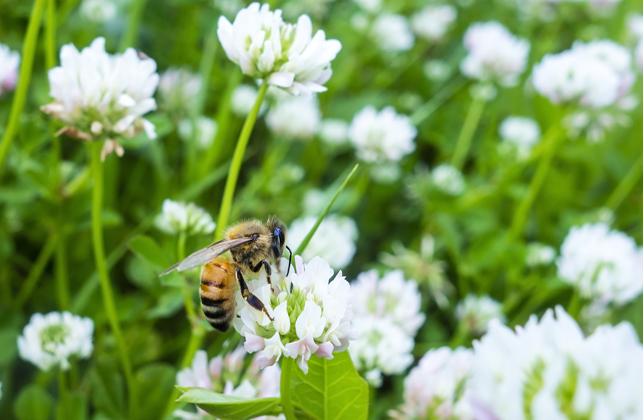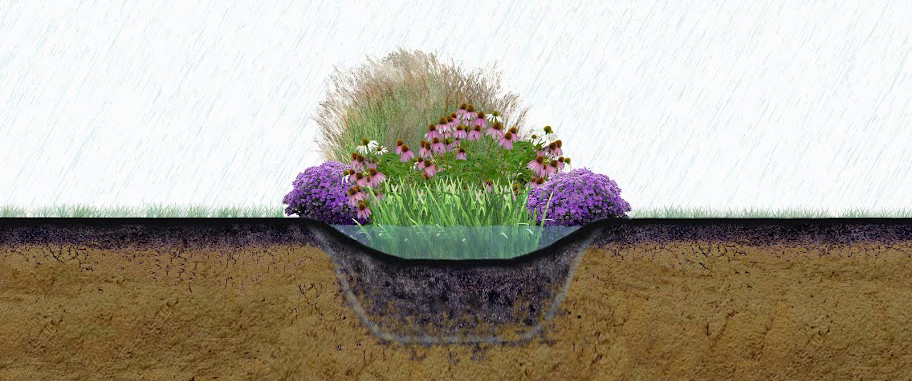What a Twentysomething Renter Learned
I have recently experienced the effects of poorly managed stormwater: water dripped from the roof and into the spaces between my apartment walls, paint on the wall in our kitchen and common hallway bubbled and cracked, our kitchen flooring became soggy and peeled right up. My husband and I had only moved in two weeks before.
But this stress-inducing event wasn’t necessarily the apartment complex’s fault. The drain on the flat-top roof was clogged, most likely with leaves, causing water to seep in anywhere it could. Mainly my apartment.
The next day I attend the Blue Thumb Resilient Yard Workshop in St. Louis Park. Although not directly applicable to my situation (Blue Thumb focuses on water coming from—not leaking into—impermeable surfaces like roofs), I am now quite interested in learning about this thing called stormwater management.
Workshop Part I: A Presentation on Our Current Landscape
Before the three hour workshop begins, I look around the room. I am a twentysomething renter, and the other fifty or so workshop attendees are a bit older, at least by a few years. They probably own property. They probably know how to keep a plant alive while I’ve struggled maintaining a very small cactus in an apartment with no direct sunlight in southern Minnesota. The other attendees probably have their lives under control, are used to living in the Cities and the rush hour traffic, are used to adulthood.
But then the workshop begins, I realize that none of us really have anything under control. The presenters, Leslie Yetka, of Freshwater Society, and Rich Harrison, a graduate landscape architect with Metro Blooms, talk to us about our current Minnesota climate and landscape. They show pictures of polluted waters and weather-ravaged landscapes; they show us statistics about our weather patterns, our changing biomes.
I remember learning about ecosystems and biomes in middle school science class, learning where certain biomes were located, what animals and plants usually inhabited those areas.
But it’s all shifting. Heat waves and droughts are increasing in frequency and duration. At the same time, when it rains it now pours. Heavy storm events are becoming more common and intense. Minnesota has seen more mega-rain events in the past 10 years than in the 30 years before that. Winters are warming the most rapidly, and noticeably. Our state—our home—is becoming less recognizable at a worrying pace.
And I think, I’ve only just gotten here, not just to Minnesota from my hometown in Indiana, but to this planet. These changes we’ve lived through, looking through that short window of time, are happening all too quickly.
During the workshop I take notes. I write, “a lot of change happening, even in my own life.” In a culture of movement, accomplishments, and productivity, maybe we need to take a moment to be still. Take a moment to decide what of our landscape we’d like to stay the same, and which of our values we should hold onto.
Our decisions, how we direct the course of our lives, affect much more than our day-to-day experiences. It seems we are inherently self-serving, but instead of making our lives more rich and abundant, we are often our own detriments.
Workshop Part II: A Presentation on Bee Lawns
In the next hour of the workshop, we split into two groups, one to hear from James Wolfin, a graduate researcher at the University of Minnesota, about bee lawns and another to speak one-on-one with a landscape architect or designer about your particular lawn and garden in a room located between two hockey rinks.
The placement there was most likely not on purpose, right?
I stay with Wolfin to learn about bee lawns and pollinator-friendly yards. I don’t have a yard of my own, but one day, in the next five to ten years, I probably will. The information from the workshop won’t seem to go to waste. It won’t cease to be applicable to my situation or life circumstances. Knowledge rarely, if ever, wastes.
Wolfin talks about lawn types, flower types, and what is attractive to pollinators. He says when we plant a bee lawn we are returning to what nature would do. He uses the term “reconciliation ecology.” And this seems like a universal truth: nature knows how to correct and “bounce-back,” be resilient. Maybe we should trust more in this system rather than creating and subscribing to our own unsustainable ones. As a twentysomething experiencing constant change, I wonder if I will be resilient as well, able to survive heavy cultural pressures and structures.
Workshop Part III: Landscape Designer and Homeowner Consultation
While sitting in on a landscape designer and a homeowner’s one-on-one session, the homeowner draws his property in detail on notebook paper and describes the slope of his front lawn as having a 30-35 degree angle, and I also realize that I am not very aware of my surroundings, how the world functions, how I am meant to function in it. As a future homeowner, I see that ownership responsibility does not come lightly. We may think that our homes are serving us, providing us with necessities, but really we could be doing so much more and more intentionally. We could practice purpose. We could practice stewardship.
At the end of the workshop, and the end of a long day of realizations and learning, we are called to awareness, to paying attention. We may even be called to question our sense of identity, our cultural norms and practices, our pace.
When the water drips, leaks, then pours through the roof and into your walls, you have to take action. You need a better system in place.
———————————————
Whether young or young at heart, an intern or professional, a new homeowner or experienced property owner or rental property manager, keep updated on latest workshop information here.
Selina Scheumann holds an MFA in creative writing and is currently the Communications Intern at Metro Blooms.


